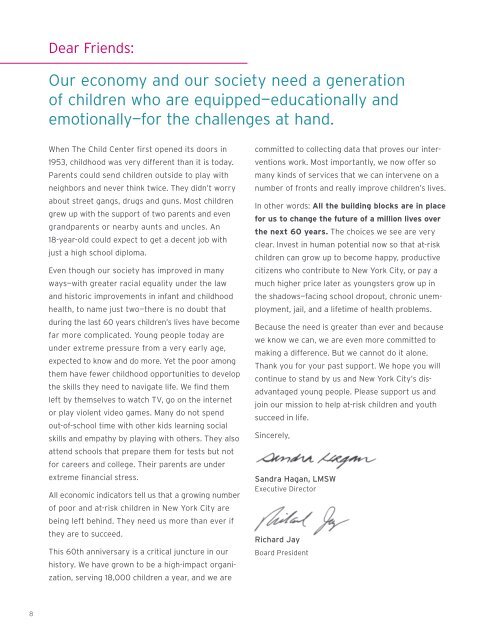Annual Report 2012 - The Child Center of NY
Annual Report 2012 - The Child Center of NY
Annual Report 2012 - The Child Center of NY
You also want an ePaper? Increase the reach of your titles
YUMPU automatically turns print PDFs into web optimized ePapers that Google loves.
8<br />
Dear Friends: Financial Highlights<br />
Our economy and our society need a generation<br />
<strong>of</strong> children who are equipped—educationally and<br />
emotionally—for the challenges at hand.<br />
When <strong>The</strong> <strong>Child</strong> <strong>Center</strong> first opened its doors in<br />
1953, childhood was very different than it is today.<br />
Parents could send children outside to play with<br />
neighbors and never think twice. <strong>The</strong>y didn’t worry<br />
about street gangs, drugs and guns. Most children<br />
grew up with the support <strong>of</strong> two parents and even<br />
grandparents or nearby aunts and uncles. An<br />
18-year-old could expect to get a decent job with<br />
just a high school diploma.<br />
even though our society has improved in many<br />
ways—with greater racial equality under the law<br />
and historic improvements in infant and childhood<br />
health, to name just two—there is no doubt that<br />
during the last 60 years children’s lives have become<br />
far more complicated. Young people today are<br />
under extreme pressure from a very early age,<br />
expected to know and do more. Yet the poor among<br />
them have fewer childhood opportunities to develop<br />
the skills they need to navigate life. We find them<br />
left by themselves to watch TV, go on the internet<br />
or play violent video games. Many do not spend<br />
out-<strong>of</strong>-school time with other kids learning social<br />
skills and empathy by playing with others. <strong>The</strong>y also<br />
attend schools that prepare them for tests but not<br />
for careers and college. <strong>The</strong>ir parents are under<br />
extreme financial stress.<br />
All economic indicators tell us that a growing number<br />
<strong>of</strong> poor and at-risk children in New York City are<br />
being left behind. <strong>The</strong>y need us more than ever if<br />
they are to succeed.<br />
This 60th anniversary is a critical juncture in our<br />
history. We have grown to be a high-impact organization,<br />
serving 18,000 children a year, and we are<br />
committed to collecting data that proves our interventions<br />
work. Most importantly, we now <strong>of</strong>fer so<br />
many kinds <strong>of</strong> services that we can intervene on a<br />
number <strong>of</strong> fronts and really improve children’s lives.<br />
In other words: All the building blocks are in place<br />
for us to change the future <strong>of</strong> a million lives over<br />
the next 60 years. <strong>The</strong> choices we see are very<br />
clear. Invest in human potential now so that at-risk<br />
children can grow up to become happy, productive<br />
citizens who contribute to New York City, or pay a<br />
much higher price later as youngsters grow up in<br />
the shadows—facing school dropout, chronic unemployment,<br />
jail, and a lifetime <strong>of</strong> health problems.<br />
Because the need is greater than ever and because<br />
we know we can, we are even more committed to<br />
making a difference. But we cannot do it alone.<br />
Thank you for your past support. We hope you will<br />
continue to stand by us and New York City’s disadvantaged<br />
young people. Please support us and<br />
join our mission to help at-risk children and youth<br />
succeed in life.<br />
sincerely,<br />
Sandra hagan, LMSw<br />
executive Director<br />
Richard Jay<br />
Board President<br />
statement <strong>of</strong> Activities & Changes in Net Assets<br />
For the year ended June 30, <strong>2012</strong> (with summarized Totals for 2011)<br />
Programs and Services<br />
90%<br />
Administration and Fundraising<br />
10%<br />
Totals<br />
<strong>2012</strong> 2011<br />
Revenues:<br />
Contract and grant services $ 19,650,747 $ 19,178,773<br />
Patient services, net 11,589,753 12,270,410<br />
Contributions 585,857 1,422,903<br />
In-kind contributions 610,641 893,793<br />
Fundraising, net <strong>of</strong> direct expenses <strong>of</strong><br />
$263,370 and $135,092, respectively 732,600 658,226<br />
Other 2,873 24,019<br />
Total revenues 33,172,471 34,448,124<br />
expenses:<br />
Program services 29,746,168 30,778,470<br />
supporting services 3,221,177 3,650,637<br />
Total expenses 32,967,345 34,429,107<br />
excess <strong>of</strong> revenues over expenses 205,126 19,017<br />
Net Assets Released From Restrictions — —<br />
Change in net assets 205,126 19,017<br />
Net Assets, Beginning <strong>of</strong> Year 111,933 92,916<br />
Net Assets, end <strong>of</strong> Year $ 317,059 $ 111,933<br />
To see our complete audited financial statement, please visit www.childcenterny.org.<br />
Who We serve<br />
Counseling<br />
30%<br />
<strong>Child</strong> Abuse<br />
Prevention<br />
11%<br />
By Program<br />
Early <strong>Child</strong>hood<br />
4%<br />
Youth<br />
Development<br />
55%<br />
How We spend Our Money<br />
Latino<br />
29%<br />
Mixed and Other<br />
10%<br />
Caucasian<br />
5%<br />
By ethnicity<br />
Asian-American<br />
17%<br />
African-American<br />
39%<br />
9 1953–2013 60 YeARs


